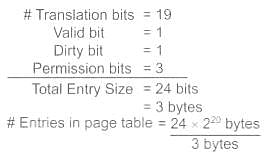Test: Paging - Computer Science Engineering (CSE) MCQ
10 Questions MCQ Test Operating System - Test: Paging
Which of the following technique is not implemented for free space management
Which of the following is not a contiguous memory management technique?
Consider a system that has 4K pages of 512 bytes in size in the logical address space. The number of bits of logical address?
Consider the following statements:
S1: A small page size causes large page tables.
S2: Internal fragmentation is increased with small pages.
S3: I/O transfers are more efficient with large pages.
Which of the following is true?
What is the size of the physical address space in a paging system which has a page table containing 64 entries of 11 bit each (including valid/invalid bit) and a page size of 512 bytes?
A computer system implements 8-kilobyte pages and a 32 - bit physical address space. Each page table entry contains a valid bit, a dirty bit, three permission bits, and the translation. If the maximum size of the page table of a process is 24 megabytes, the length of the virtual address supported by the system is ________ bits.
A computer uses 46-bit virtual address, 32-bit physical address, and a three-level paged page table organization. The page table base register stores the base address of the first-level table (T1), which occupies exactly one page. Each entry of T1 stores the base address of a page of the second-level table (T2). Each entry of T2 stores the base address of a page of the third-level table (T3). Each entry of T3 stores a page table entry (PTE). The PTE is 32 bits in size. The processor used in the computer has a 1 MB 16-way set associative virtually indexed physically tagged cache. The cache block size is 64 bytes.
What is the size of a page in KB in this computer?
Consider a system with byte-addressable memory, 32-bit logical addresses, 4 kilobyte page size and page table entries of 4 bytes each. The size of the page table in the system in megabytes is _______.
Consider a paging system with a page size of 4 KB. If a process of size 38 KB is in logical address space, find the internal fragmentation in Kbytes.
A machine has 64-bit virtual addresses and 48-bit physical addresses. Pages are 16K. How many entries are needed for a conventional page table?
|
10 videos|99 docs|33 tests
|






















